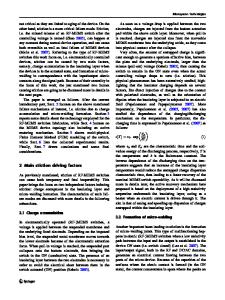Reliability of MEMS Materials: Mechanical Characterization of Thin-Films using the Wafer Scale Bulge Test and Improved M
- PDF / 7,971,134 Bytes
- 6 Pages / 612 x 792 pts (letter) Page_size
- 86 Downloads / 408 Views
1052-DD01-02
Reliability of MEMS Materials: Mechanical Characterization of Thin-Films using the Wafer Scale Bulge Test and Improved Microtensile Techniques Joao Gaspar, Marek Schmidt, Jochen Held, and Oliver Paul Department of Microsystems Engineering - IMTEK, Microsystems Materials Laboratory, University of Freiburg, Georges-Koehler-Allee 103, Freiburg, 79110, Germany ABSTRACT This paper reports on recent improvements of the bulge and microtensile techniques for the reliable extraction of material parameters such as the Young’s modulus E, Poisson’s ratio ν, plane strain modulus Eps = E/(1−ν2), prestress σ0, fracture strength µ, Weibull modulus m and strain hardening coefficients n, and on the direct comparison between the two methods. The bulge technique is extended to full wafer measurements enabling throughputs of data with statistical relevance whereas key improvements of a previous fabrication process of microtensile specimens lead now to much higher yields, approaching 100%. Both techniques are applied to an extensive set of materials, brittle and ductile, typically used in MEMS applications. These include thin films of silicon nitride, silicon oxide, polycrystalline silicon and aluminum deposited by techniques such as thermal oxidation, LPCVD, PECVD and PVD. INTRODUCTION The mechanical characterization of thin films is of great importance for their use in integrated circuits and as structural materials in microelectromechanical systems since device functionality and reliability depend strongly on mechanical parameters. Deviations of materials mechanical behavior from the macro to the microscale demand novel characterization methods or adjustment of current ones for the reliable extraction of both elastic and fracture properties. Established techniques that have been used to characterize a wide variety of thin film materials include the wafer curvature method, beam buckling analysis, nanoindentation, pull-in voltage experiments, measurements of resonance frequency, and bulge and microtensile tests [1]. The bulge test consists on the measurement of the load-deflection response of membranes under applied pressure P [1]. A multilayer mechanical model for the plane strain deformation of long membranes, where the compliance of the supporting edges is included through a spring constant K, has been recently developed [2], and is here used to characterize homogeneous and composite diaphragms made of different materials. A bulge setup, automated for the measurement of up to 80 membranes on a silicon wafer, enables the extraction of mechanical data with statistical significance, as never reported before for this technique. In addition, the stress distribution within the diaphragms at the moment of failure is computed and used to analyze the brittle material strength via Weibull distributions [2-4], extending this technique to the consistent fracture analysis of poly-Si thin films. The tensile method is one of the most fundamental, simplest and best-standardized mechanical tests [5]. Its main advantage resides in the fa
Data Loading...











